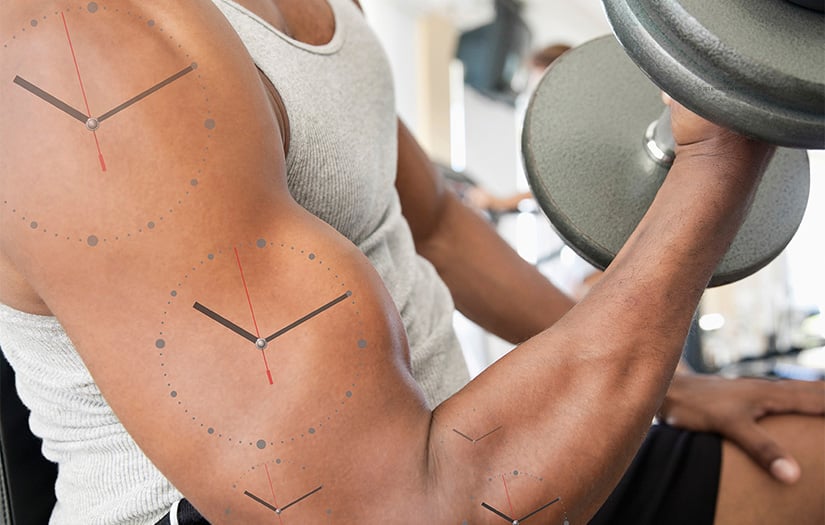Many exercisers and athletes prefer to train at the same time every day. They may suggest a variety of reasons for this: That’s when they feel most awake, least hungry, most focused or least stressed.
They may even say it seems easier to work out at a consistent hour. They’re probably right: But the reason is not merely psychological. It’s biological, too. And it all begins with something that everyone has but most have never heard of: a collection of muscle clocks.
As a CPT, knowing this all-important principle of biology can help inform the exercise programming you prescribe to clients.
This article originally appeared in the Fall 2020 Issue of American Fitness Magazine.
What are Muscle Clocks?
Muscle clocks are internal timekeepers that reside in muscles in the body, in much the same way that the master circadian clock resides in the brain.While the master clock monitors and regulates the rhythms of the body as a whole, muscle clocks are primarily responsible for synchronizing daily muscle activity with the rest of the body and the environment surrounding it.
When skeletal muscles, biological systems and environmental events are synchronized, a rhythm is established that benefits the entire body, influencing sports and fitness performance, disease prevention, and overall health (Mayeuf-Louchart, Staels & Duez 2015).
Learning what makes muscle clocks tick, both on a cellular level and systemwide, can help you understand the basis for synchronized training. Here, you will find an overview of the biology of muscle clocks and the programming principles—including biometrical similarity and intermittent rest—that are based on them, as well as sample programs illustrating their use.
By considering these factors when creating programming, you can help clients reap more benefits from each exercise session, while also improving overall health and disease prevention in the long term.

The purpose of all internal clocks, including muscle clocks, is to use information about the timing of events inside and outside of the body to align the body with the environment on a 24-hour schedule.
Why Muscle Clocks Are Key
Because body mass is over 40% muscle, this type of tissue has a powerful influence over the body. Additionally, there are more than 600 skeletal muscles, and each one has its own clock; therefore, there are more than 600 independent muscle clocks in the body.
Every 24-hour period, these muscle clocks work to synchronize skeletal muscle activity to the master clock located in the brain.
Furthermore, muscle clocks work to align daily muscle activity with natural body cycles (like fluctuations in hormone levels and body temperature); with other organs and systems in the body (affecting the digestive system, liver and eating habits, for example); and with external environmental events (like day and night changes in light levels).
Muscle clocks also communicate among themselves and with other clocks in the musculoskeletal system, including tendon and ligament clocks.
It is important to note that although the master clock in the brain exerts direct control over muscle clocks, these clocks do not exert direct control over the master clock; however, via exercise (as shown later), muscle clocks do indirectly influence the master clock.
How Muscle Clocks Communicate
Synchronization of muscles and body systems occurs through a complex system of communication at the cellular level. Muscle clocks are actually genes, also termed transcription factors, made up of proteins that help regulate muscle function.
When skeletal muscles contract repeatedly (as during exercise), they release myokines, a type of protein specific to muscles. Other body systems (including the master clock) recognize myokines as a signal that muscles are working.
It is through this release-and-recognition pattern that skeletal muscles and other body systems communicate and, ultimately, become synchronized during and after exercise to maximize performance and health benefits. The key to understanding how muscle clocks can optimize health and fitness is to recognize how they rely on timing.
Why Fitness Timing Matters to Muscles
The purpose of all internal clocks, including muscle clocks, is to use information about the timing of events inside and outside of the body to align the body with the environment on a 24-hour schedule. Sticking to a regular workout schedule generates a circadian rhythm that prepares muscles and other body systems for daily activity and rest times each day.
Timing in fitness and sports refers to more than the time of day when exercise takes place. It also has to do with adhering to a regular exercise schedule that is in alignment with changes that naturally occur in the body and muscles daily.
These changes include fluctuations in hormone levels and muscle pliability, as well as time-of-day variations in oxygen utilization and levels of biochemical substrates (molecules acted on by enzymes) that are specific to muscle performance peak.
When myokines are released during exercise, they do more than provide information about immediate muscle activity; they also relay timing cues that help the body know when a muscle is active relative to the time of day.
Should you exercise at the same time everyday?
Exercising during the same time every day is a good idea. When exercise is done systematically—providing repeated, scheduled skeletal muscle contractions at the same time daily—the body learns when to expect exercise (versus rest) each day.
This allows muscle clocks to do their jobs to improve muscle performance, synchronize muscles to other body systems, and increase health and fitness (Mayeuf-Louchart, Staels & Duez 2015).
What Research Says About Muscle Clocks
Although muscle clocks were discovered in the early 2000s, developing the ability to create exercise programs based on them is a recent endeavor.
Here are details on two studies that have provided strong evidence of the impact of workout timing.
The first focuses on the time of day when exercise occurs, and the second illustrates the benefits of sticking to a regular schedule.
WHAT HAPPENS AFTER ONE WORKOUT
In a small study conducted this year, Tanaka et al. (2020) examined the effects of exercise on the level and timing of clock gene expression in leukocytes, a type of blood cell that expresses key proteins that regulate muscle metabolism.
For this research, 11 young men ages 20–30 were assigned to three different groups: a morning exercise group, an afternoon exercise group and a control group that did not exercise. Each exercise group performed a single bout of exercise on a bicycle ergometer at 60% of VO2max for 1 hour at either 7 a.m. (morning exercise) or 4 p.m. (afternoon exercise). The subjects were defined as physically active but were not habitually trained athletes.
For all study groups, blood samples were collected on the day of the exercise bout at seven different times: 6 a.m., 9 a.m., noon, 3 p.m., 6 p.m., 9 p.m. and 11 p.m. A final blood sample was collected at 6 a.m. the next morning to show 24-hour changes in muscle clock gene expression. Specifically, researchers looked at the levels of two proteins that relate to the body’s clocks and daily rhythms: ARNT-like protein 1 (BMAL1) and cryptochrome 1 protein (CRY1).
Subjects in the no-workout group did not show changes in the behavior of muscle clock proteins; however, the exercise groups showed a general trend of muscle clock proteins altering their behavior during exercise, suggesting that exercise affects muscle clock functioning. This is congruent with a previous study on rodents that involved muscle clock response to scheduled exercise (Wolff & Esser 2012). Here are additional details from the Tanaka et al. study:
First, researchers found that BMAL1 increased after exercise in both the morning and the afternoon. This is important because BMAL1 regulates muscle clocks. When BMAL1 is rendered ineffective, the muscle clocks’ natural rhythm is knocked out, too. What this data shows is that muscle clock proteins recognize and respond to exercise. The finding that BMAL1 is activated during exercise demonstrates that muscle clocks are learning when to expect exercise to occur each day.
In this same study, researchers found that CRY1 also increased with morning exercise, but not with exercise in the afternoon. CRYl is another protein that controls body clocks and daily 24-hour rhythms. This finding indicates that muscles are more susceptible to exercise timing suggestions in the morning than in the afternoon. Because both BMAL1 and CRY1 were higher after the 7 a.m. workout, it appears that muscle clocks are more likely to respond and adapt to a regularly scheduled morning exercise routine.
The researchers also looked at how the timing of workouts affected the acrophase (or peak of cycle) of BMAL1 expression. Not surprisingly, BMAL1 levels peaked earlier in the morning for the 7 a.m. exercise group and later in the afternoon for the 4 p.m. exercise group. This shows that the timing of exercise shifted the timing of the release of muscle clock proteins. Because muscle clocks and other biological clocks are in constant communication, this means exercise timing affects the circadian clock and the body as a whole.
Finally, as this study involved just one bout of exercise, it suggests that a single workout session can modify muscle clocks—and, thus, other biological clocks—and help to synchronize circadian rhythms in humans.
WHAT HAPPENS AFTER REPEATED SCHEDULED WORKOUTS
Although not discussed in the 2020 study, researchers Chaix and Panda (2019) theorized that repeated bouts of exercise (done at the same time each day) would produce a stronger effect on muscle clocks and that this, in turn, would have a more positive effect on whole-body system synchronization. Their conclusion: Following a regularly scheduled exercise program would likely lead to greater improvements in fitness and sports outcomes, as well as increased overall health and disease prevention.
To illustrate the specific effects of repeated bouts of exercise, Murphy et al. (2014) examined the ability of muscles in schedule-trained race horses to anticipate upcoming exercise sessions. This was done by measuring uncoupling protein 3 (UCP3), a factor critical to the synthesis of ATP into energy. (This mitochondrial protein is also known to possess a circadian rhythm that bridges the gap between muscle clocks and muscle function.)
Researchers took repeated measurements of UCP3 before the horses performed their regularly scheduled training. The data showed that the peak expression of UCP3 preceded this training. That indicates that the horses’ muscles had learned to anticipate the scheduled exercise and, as a direct result, their bodies began to prep for it by generating extra UCP3 early enough to allow the horses to enter the exercise session well-prepared to meet its physical demands.
These findings support the notion that muscles can learn to anticipate exercise based on time of day. Simply put: When exercise happens repeatedly on a set schedule, muscles begin to expect it. As a result, about 30 minutes before an anticipated workout session, the body will “switch on” the physiological processes associated with muscle performance outcomes (Ashmore 2020).
When taken together, the research on time-related responses of BMAL1, CRY1 and UPC3 makes a strong argument that muscles benefit from a regular exercise schedule, which in turn benefits the entire body through synchronization.
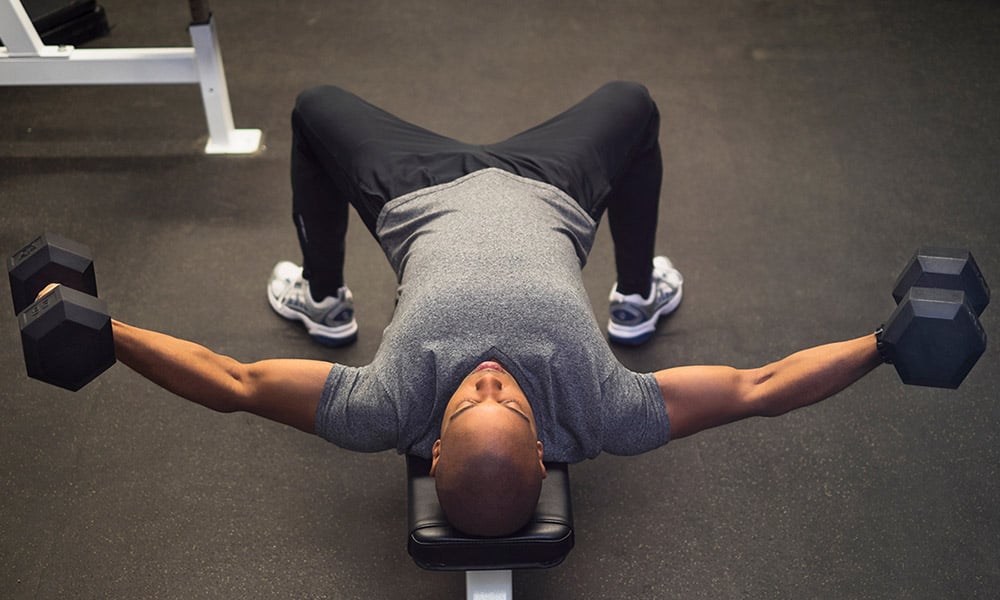
Because muscle clocks tend to respond best to continuous, rhythmic movement (such as elliptical training), resistance training should be carefully programmed to provide the consistent cues that muscle clocks look for.
What to Consider When Creating a Synchronized Program
Synchronization of the muscles and body systems is made possible by thoughtful and strategic exercise programming. To function properly, muscle clocks rely on consistent cues from their environment about the timing of daily events, including exercise (Schroeder & Esser 2013); therefore, the better an exercise program is synchronized to natural body cycles, the more effective it will be.
When it comes to programming exercise, the cues that muscle clocks look for are time of day of exercise, type of exercise and activity-rest durations. Using these three key programming variables strategically is the key to maximizing benefits, based on our current knowledge about muscle clocks.
WHEN TO SCHEDULE CARDIOVASCULAR TRAINING
The time of day when exercise is performed is critically important to its effectiveness. Based on the Tanaka et al. study, doing cardiovascular exercise at different times of the day influences human muscle clocks in different ways. Although both morning and afternoon exercise bouts have been shown to increase activity for one type of muscle clock protein (BMAL1), morning exercise seems to be preferred because it promotes changes in two types of key proteins (BMAL1 and CRY1).
This demonstrates that exercised muscles synchronize to other body systems more effectively in the morning. The resultant data indicates that for overall health and general fitness and sports goals, morning exercise would be the better choice—at least for cardiovascular exercise or, more specifically, cycling. However, the “best” time to exercise is not so cut-and-dried.
The relationship between time of day and overall efficacy of exercise gets more complicated when we consider substrates that fluctuate on a 24-hour basis, such as oxygen and other metabolites associated with exercise performance. For example, how the body uses oxygen varies throughout the day—and from one day to the next. When oxygen uptake is the sole factor under consideration, exercise performance is better late in the day.
One study showed that when 12 people were asked to jog at a low-to-moderate intensity at different times of day, oxygen uptake was more efficient in the evening. However, high-intensity training did not show a time-of-day preference (Gabriel & Zierath 2019). Another study (Sato et al. 2019) found a preference for metabolic activity, including fat utilization, in the late morning. This indicates that if weight loss is the goal, morning exercise may be a better fit. However, this study was done with mice, so additional research in this area is needed with human subjects.
There is still a lot to be discovered about the optimal time of day to exercise, but given where the research stands now—and the direction it appears to be headed per circadian functioning—late-morning cardiovascular training seems to be the emerging favorite for synchronizing metabolism and other body systems. It is important to note, however, that this does not discredit the value of exercise at other times of day, nor does it discount additional modes of exercise, like resistance training, as effective ways to achieve desired results.

When exercise happens repeatedly on a set schedule, muscles begin to expect it. As a result, about 30 minutes before an anticipated workout session, the body will “switch on” the physiological processes associated with muscle performance outcomes.
WHEN TO SCHEDULE RESISTANCE TRAINING
As discussed, muscle clocks seem to respond well to the rhythmic movement associated with cardiovascular exercises like jogging, elliptical training and cycling. However, resistance training can also provide muscle clocks with invaluable cues about exercise timing.
During resistance training, myokines are released (just as they are during cardiovascular exercise), signaling the rest of the body that exercise is happening. Key hormones—including testosterone, human growth hormone, cortisol and lactate (aka lactic acid)—are also released during this type of workout. All of these hormones affect the local muscle environment and signal ongoing exercise to muscle clocks and other body systems.
Because muscle clocks tend to respond best to continuous, rhythmic movement (such as elliptical training), resistance training should be carefully programmed to provide the consistent cues that muscle clocks look for. The suggested method for doing this is to plan progressions based on biomechanical similarity, defined as the degree to which two exercises are alike. With biomechanical similarity, exercise-specific timing cues about the type of exercise are provided to muscle clocks based on the primary joints used and muscles trained (Ashmore 2020).
For example, a supine glute bridge and a deadlift both involve hip extension; therefore, they use similar joints and muscle actions. Thus, these exercises are biomechanically similar. In another example, a leg press and a back squat both use the quadriceps, hamstrings and gluteus maximus as the primary movers; therefore, these exercises use the same joints and muscles and are biomechanically similar.
A best practice is to use biomechanically similar exercises within a resistance training session to maximize the efficacy of the cues delivered to muscle clocks; these cues include which muscles are working and what type of exercise is being done. Suggestions for creating a program using this approach include building workouts around the same muscle groups (for example hip abductors and adductors) or building workouts around paired joints (like shoulder and shoulder girdle joints). This aids synchronization by sending consistent cues about the type of exercise that is occurring and when it is happening.
It is also worth noting that the suggested time of day for resistance training is different than it is for cardiovascular exercise, in particular if the training’s intent is muscle strength and power development. It’s at around 4 p.m. that body temperature peaks and muscles are at their most pliable. This time also marks the end of testosterone’s peak in the daily cycle. For these reasons, many people prefer this time of day for resistance training.
WHEN TO SCHEDULE REST AND RECOVERY
Like all body systems, muscle clocks rely on a consistent 24-hour daily on-off schedule. Whereas the master clock in the brain primarily responds to day-night and awake-asleep cycles, muscle clocks monitor activity-rest cycles over each 24-hour period. Because of this, exercise-rest schedules should reinforce a 24-hour schedule.
Intermittent rest refers to the timing of rest over a 24-hour period; it is done to align rest/recovery days with the muscle clocks’ need for a 24-hour schedule. The concept of intermittent rest is adapted from the idea of intermittent fasting, which proposes alternating periods of eating and not eating (fasting). For example, a person might break a 24-hour day into two periods: a 14-hour period of fasting and a 10-hour window of time in which eating can occur. (The specific timing in this example is not important; it is just meant to illustrate the concept itself.)
Intermittent rest is built on the premise of alternating periods of exercising and not exercising (resting). While intermittent fasting is typically expressed in hours, intermittent-rest training is based on 24-hour cycles. It suggests that each week should include 5 days of training interspersed with 2 nonconsecutive days of rest (Ashmore 2020).
It is important to note that this schedule is contrary to the popular approach of training every weekday and taking the weekend off. The rationale behind an intermittent-rest schedule is that the master clock in the brain synchronizes all clocks to a 24-hour schedule, and this resets every 24 hours. Therefore, all body clocks, including those located in the musculoskeletal system, are looking for 24-hour schedules and rhythms to sync to.
Taking the weekend off—or training on Friday evening and not again until Monday evening—confuses the body’s 24-hour clocks. In fact, too much consecutive time off can lead to desynchronization.
For an in-depth guide to active recovery workouts and rest days, follow the link. Active recovery has a lot do with the muscle clocks and overall workout timing!
Why Time Is of the Essence
Since the discovery of muscle clocks, the ability to synchronize muscle systems to other biological systems—through carefully timed programming—has emerged as a powerful tool for fitness professionals and athletes alike. While this is a relatively new area of study, you don’t have to wait another minute to implement the findings discussed here and set your clients on the fast track to success.
By utilizing existing knowledge of time-based training—identifying the best time of day to exercise, utilizing concepts like biomechanical similarity and intermittent rest, and synchronizing muscles to other naturally occurring daily cycles—you can help clients achieve their fitness and wellness goals.
Cardio Timing and Muscle Clock Proteins
This table describes the behavior of two key muscle clock proteins—ARNT-like protein 1 (BMAL1) and cryptochrome 1 protein (CRY1) during cardiovascular exercise.
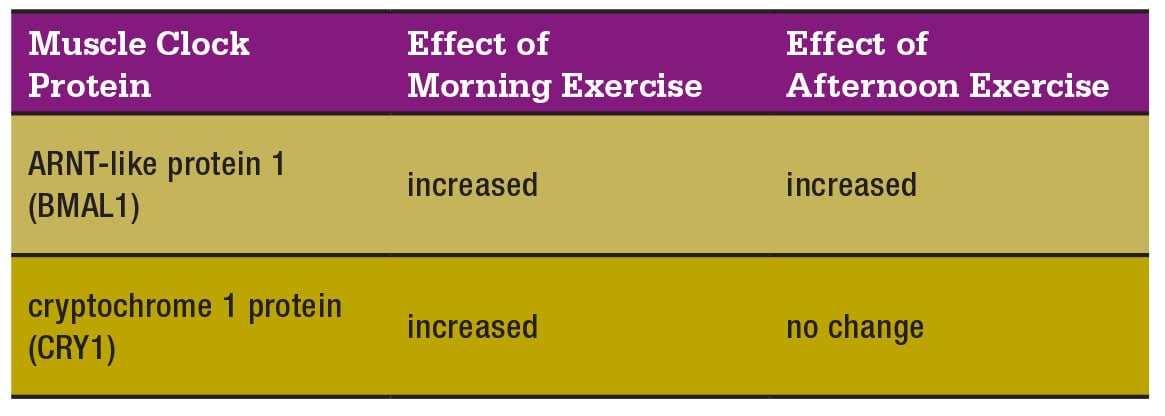
The point is that both muscle clock proteins respond to morning exercise, while only one responds to afternoon exercise. This finding suggests that for synchronizing themselves to other body systems, muscle clocks are more susceptible to the influences of morning exercise.
Adapted from Tanaka et al. 2020.
Additional Variables That Influence “Optimal” Timing
In a 2020 study focused on the potential benefits of time-restricted eating, Parr, Heilbronn & Hawley explored how these might compare with and/or complement the benefits of exercise interventions. As part of the discussion, they noted that timing exercise to “maximize health benefits” can be a challenge, because outcomes are also affected by other variables, including the person’s current health status (e.g., cardiovascular disease or type 2 diabetes) and existing biorhythms (e.g., sleep-wake cycle timing).
For example, someone looking to lower blood sugar may benefit from engaging in cardiovascular exercise in the afternoon or evening, as this is when research has shown that physical activity improves glycemic control. Fitness professionals must further consider the feasibility of the timing suggestions in their programs.
Read more: Nutrient Timing - Pre and Post-Workout Questions Answered
For clients who work from 9 a.m. to 5 p.m., the sample cycling program on page 32 (with 10–11 a.m. workouts) may be impossible to follow. However, shifting the timing to 7–8 a.m. each day could be workable, enabling people to still benefit from the muscle clock behavior associated with morning workouts. Even if particular clients cannot benefit from all of the information in this article, they will likely be able to incorporate some of the suggestions successfully.
For example, it is relatively simple to encourage clients to stop taking weekends off and instead follow the recommendation on intermittent rest. By making even minor tweaks like these, you can help clients get one step closer to reaching their personal goals.
Biomechanical-Similarity Training Using Paired Joints
This is an example of a resistance training program that focuses on paired joints—specifically the shoulder and shoulder girdle.
Sample Program for Shoulder and Shoulder Girdle Joint
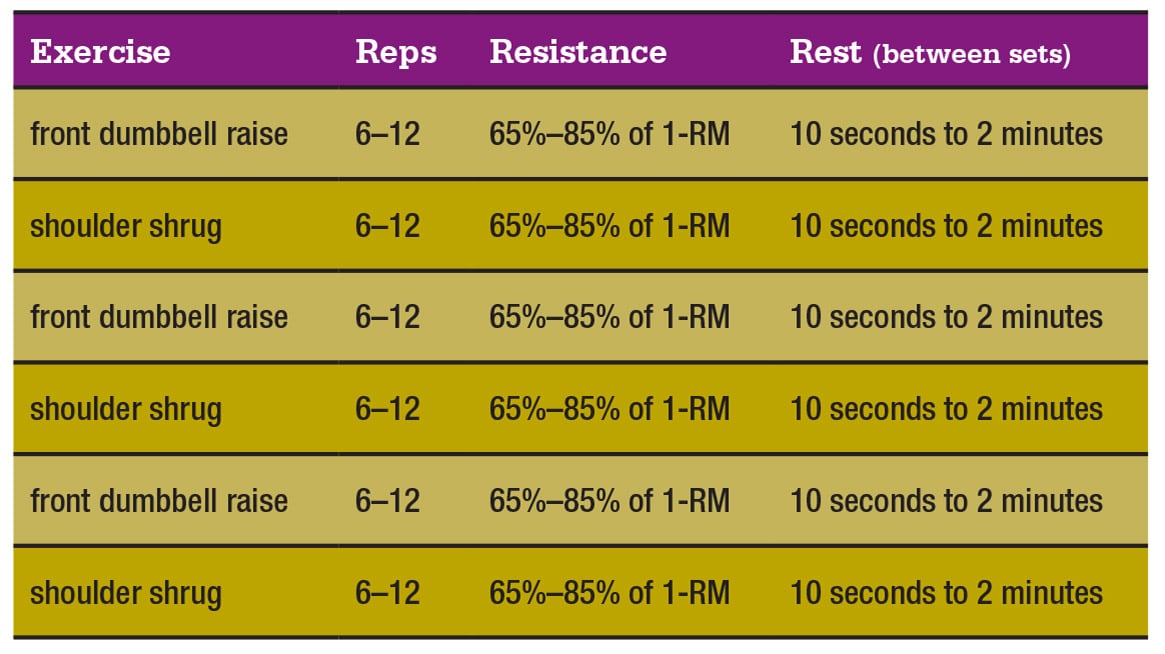
Biomechanical-Similarity Training Using Muscle Groups: Upper Body
This is an example of a resistance training program that focuses on working muscles from the same muscle group—specifically the triceps.
Sample Program for the Triceps
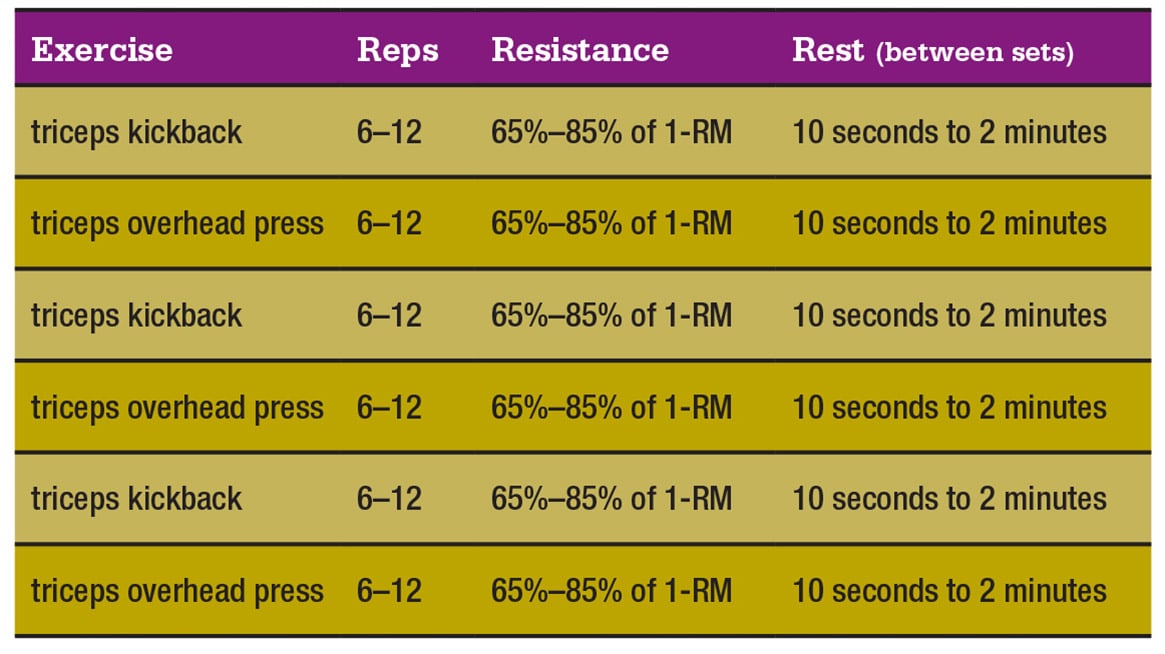
Biomechanical-Similarity Training Using Muscle Groups: Lower Body
This is an example of a resistance training program that focuses on working muscle groups from the same area of the body.
Sample Program for the Legs

Cardiovascular Training Based On Muscle Clock Behavior
This is a sample week of cardiovascular training based on muscle clock behavior, including the principle of intermittent rest. The suggested time of day is based on clock behavior and metabolic characteristics in the mid-to-late morning.

Programming notes:
1. Any continuous, rhythmic cardiovascular exercise can be substituted for cycling.
2. Intensity and volume should be modified to best suit the individual.
3. Rest days are programmed based on intermittent-rest principles (2 nonconsecutive days).
4. Yoga is scheduled on Thursday to ensure only 2 days of rest within the week.
REFERENCES
Ashmore, A. 2020. Timing Resistance Training: Programming the Muscle Clock for Optimal Performance. Champaign, IL: Human Kinetics.
Chaix, A., & Panda S. 2019. Timing tweaks exercise. Nature Reviews Endocrinology, 15 (8), 440–41.
Gabriel, B.M., & Zierath, J.R., 2019. Circadian rhythms and exercise—re-setting the clock in metabolic disease. Nature Reviews Endocrinology, 15 (4), 197–206.
Mayeuf-Louchart, A., Staels, B., & Duez, H. 2015. Skeletal muscle functions around the clock. Diabetes, Obesity, and Metabolism, 17 (1, Suppl.), 39–46.
Murphy, B.A., et al. 2014. Exercise influences circadian gene expression in equine skeletal muscle. Veterinary Journal, 201 (1), 39–45.
Parr, E.B., Heilbronn, L.K., & Hawley, J.A. 2020. A time to eat and a time to exercise. Exercise and Sport Sciences Reviews, 48 (1), 4–10.
Sato, S., et al. 2019. Time of exercise specifies the impact on muscle metabolic pathways and systemic energy homeostasis. Cell Metabolism, 30 (1), 92–110.
Schroder, E.A., & Esser, K.A. 2013. Circadian rhythms, skeletal muscle molecular clocks, and exercise. Exercise Sport Science Review, 41 (4), 224–29.
Tanaka, Y., et al. 2020. Effect of a single bout of exercise on clock gene expression in human leukocyte. Journal of Applied Physiology, 128 (4), 847–54.
Wolff, G., & Esser, K.A. 2012. Scheduled exercise phase shifts the circadian clock in skeletal muscle. Medicine & Science in Sports & Exercise, 44 (9), 1663–70.

